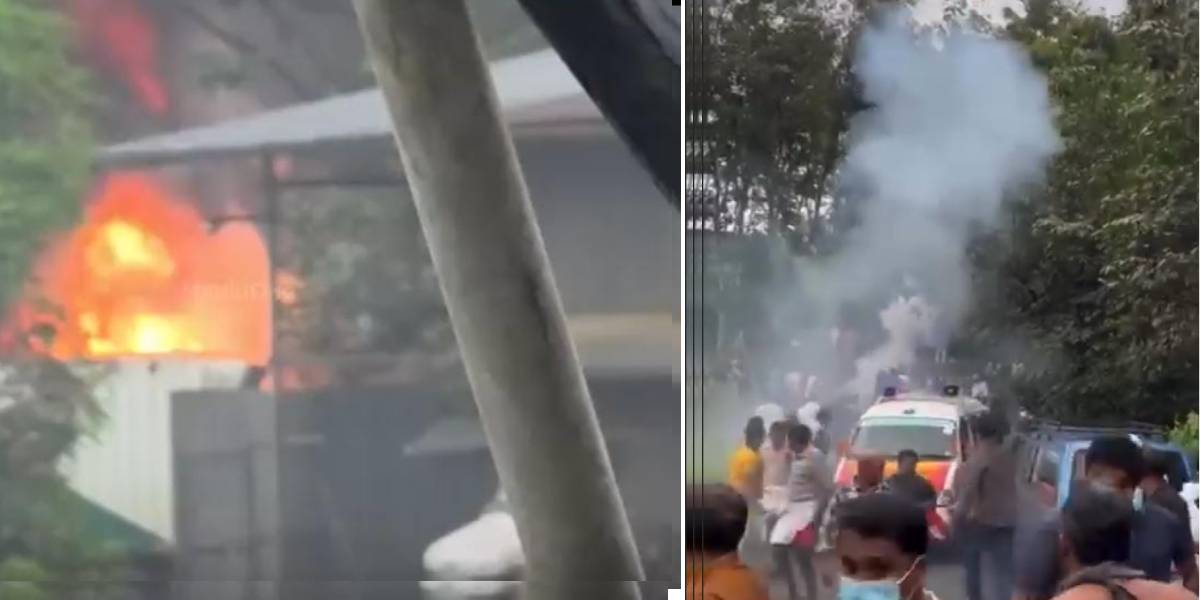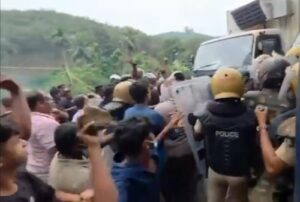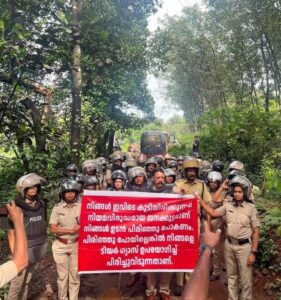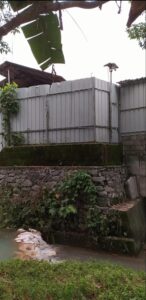Tensions flared when a company vehicle attempted to pass through the protest site and was pelted with stones. Police fired multiple rounds of tear gas shells to disperse the mob and later resorted to a lathi-charge.
Published Oct 21, 2025 | 10:19 PM ⚊ Updated Oct 22, 2025 | 8:19 AM

Enraged protesters reportedly set the factory on fire, causing extensive damage to the facility. (Right) Police fired teargas shells to disperse the mob.
Synopsis: Residents of Thamarassery, Kodencheri, and Omassery panchayats alleged that the stench from the plant has made daily life unbearable and that untreated effluents have been contaminating the Iruthulli River, a crucial water source.
A long-simmering conflict over a controversial poultry waste treatment plant in Thamarassery, Kozhikode, turned violent on Tuesday, 21 October, when a protest demanding the closure of the Fresh Cut facility became chaotic at Ambayathode.
What began as a peaceful agitation by residents, frustrated by years of inaction over their complaints of unbearable stench and pollution, spiralled into arson, stone-pelting, and a police lathi-charge.
According to police, tensions flared when a company vehicle attempted to pass through the protest site and was pelted with stones.
Several police personnel, including Kozhikode Rural SP KE Baiju and Thamarassery CI Sayuj, were injured in the attack. In response, police fired multiple rounds of teargas shells and later resorted to a lathi-charge to disperse the mob.
Amid the chaos, enraged protesters reportedly set the factory on fire, causing extensive damage to the facility.
The situation was eventually brought under control. Visuals of thick smoke billowing from the plant spread rapidly on social media.
Security has since been tightened in and around the facility to prevent further flare-ups.
Nestled in the verdant folds of Kattippara panchayat, about 40 km east of Kozhikode city, the Fresh Cut plant was conceived as a modern answer to Kerala’s mounting slaughterhouse waste problem.

Tensions flared when a company vehicle attempted to pass through the protest site.
Established in 2014 by Fresh Cut Organic Products Pvt Ltd, it was meant to process the district’s daily heaps of poultry waste—feathers, offal, and carcasses—into usable byproducts like animal feed and biogas.
The facility serves not only the local panchayats but also the Kozhikode Corporation, which depends heavily on it for waste disposal.
As per the company website, the unit is working in collaboration with the district panchayat and the Corporation to eliminate waste from all poultry shops in the district.
“At present, an average of 15 tonnes of poultry waste is processed on Mondays to Fridays and 30 tonnes on holidays. The waste is transported to the treatment plant at Kattippara in a vehicle with freezer facility from different parts of the district. The shop owner has to pay ₹7 per kg for the waste stored in the freezer in the chicken shops. All the poultry in the urban areas supply waste to this company,” read an excerpt from the website.
But from the very beginning, the project’s promise curdled into a public nightmare.
Residents in neighbouring Thamarassery, Kodencheri, and Omassery panchayats alleged that the stench from the plant has made daily life unbearable and that untreated effluents have been contaminating the Iruthulli River, a crucial water source.
“The factory has destroyed our peace. The stench never goes away, day or night,” said Ravi of the Iruthulli River Protection Committee, which has been leading the agitation.
“The plant has a permitted capacity of just 20 tonnes a day, but it processes close to 200 tonnes. That’s ten times the limit—and ten times the misery,” he added.
Protests against the facility have erupted periodically over the past five years.

Police warn of firing teargas shells if the crowd did not disperse.
In September 2020, over 500 residents blockaded the plant for three days, forcing a temporary shutdown. But operations resumed weeks later after what locals called, “cosmetic” fixes.
By 2023, the issue took a public health turn when a spate of respiratory illnesses in nearby Kodencheri was linked by a local NGO to airborne particulates from the plant.
Women’s groups, farmers’ unions, and even the Thamarassery Catholic Diocese joined the protests, calling it an environmental justice movement.
In July 2024, following petitions by residents, the Kerala High Court ordered the State Pollution Control Board to re-inspect the facility. The board’s August 2024 report found the plant in violation of emission and waste segregation norms, intensifying public anger.
Protests peaked in March 2025, when nearly 2,000 people blocked the Thamarassery Ghat Road, demanding the plant’s permanent closure.
The agitation forced a month-long shutdown in May, but operations quietly resumed soon after—without any of the promised corrective measures, according to residents.
Despite mounting pressure, the Kattippara panchayat in July refused to renew the plant’s trade licence. “We cannot renew the licence of a venture that causes so much hardship,” the panchayat said.

A 2021 picture of waste dumped into a water body near the plant.
However, the company continued operating under clearance from the District Level Facilitation and Monitoring Committee (DLFMC), deepening public resentment.
Meetings convened by the district administration failed to yield a breakthrough, as residents demanded an immediate halt to all waste transport to the site.
In recent weeks, protesters—under the banner of the Iruthulli River Protection Committee and Karimpalakunnu Protection Committee—had escalated their campaign into a day-and-night road blockade, demanding that the factory limit its operations to 25 tonnes, stop bringing waste at night, and allow community monitoring.
Tensions reached a tipping point on Tuesday. According to eyewitnesses, hundreds of residents, including women and children, gathered near the factory gates. A vehicle carrying poultry waste tried to pass through the blockade, triggering the confrontation.
As tempers rose, stones were thrown, teargas shells were fired, and the once-peaceful demonstration descended into chaos. “We had no choice but to protect ourselves,” a police officer said. “The crowd became uncontrollable.”
By evening, flames engulfed the factory, symbolising years of frustration that had finally burst into fury. Several protesters and police personnel were injured and admitted to Thamarassery Taluk Hospital.
According to police, protesters set fire to several vehicles and attacked the factory premises. Nine lorries, one autorickshaw, and three motorbikes were completely gutted, while three other lorries were smashed by the mob.
The fire, which raged for nearly four hours, was finally brought under control by fire and rescue units from Mukkam and Narikkuni. Police described the scene as “war-like,” with thick smoke and flames engulfing the area around the factory.
Kozhikode Range Deputy Inspector General (DIG) Yatheesh Chandra said the assault was a “pre-planned attack” orchestrated by vested interests, adding that women and children were allegedly used as human shields during the violence. He stated that those behind the attack have been identified.
The DIG also condemned the act as “inhuman,” noting that the factory was set ablaze while employees were still inside and that fire engines attempting to douse the flames were obstructed by the mob.
Around 16 police personnel, including the District Police Chief and the Thamarassery Station House Officer, sustained serious injuries in the clashes. A partial hartal has also been declared for Wednesday in several wards of Omassery, Thamarassery, Kodanchery and Koduvally local bodies.
Meanwhile, Koduvally MLA MK Muneer condemned the police action against the residents. “The police brutality against the peaceful protest demanding the closure of the foul-smelling Fresh Cut waste treatment plant, which threatens the health and peaceful life of the people, is highly condemnable,” Muneer said.
He alleged that many protesters were injured after police resorted to tear gas and force “without any provocation.”
Calling the incident “an attack on peaceful protesters,” the MLA demanded that authorities take immediate steps to shut down the facility, which locals claim has been causing unbearable stench and health hazards in the area.
The violent turn has forced renewed attention on a problem that Kozhikode has struggled with for over a decade—how to manage slaughterhouse waste responsibly and equitably.
Attempts to set up alternative plants elsewhere in the district have repeatedly failed due to local opposition.
Ironically, the protesters at Thamarassery said they were not against waste treatment facilities altogether—only that such plants should not be located near human settlements or riverbanks.
“We are not against development,” a protester said. “But our right to breathe clean air cannot be sacrificed for the city’s convenience.”
As the smoke clears over Ambayathode, Kozhikode is left to grapple with a pungent reminder: Environmental neglect and administrative inertia can turn even the stink of waste into the spark of unrest.
(Edited by Majnu Babu).
